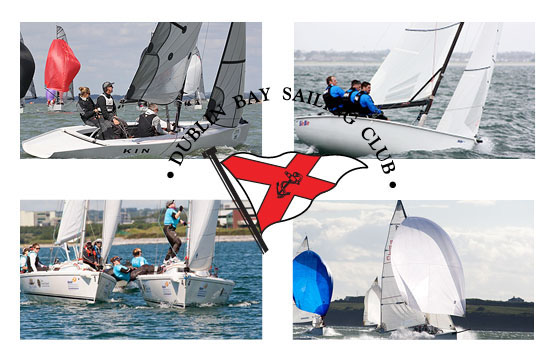Providing a mixed sportsboats class in Dublin Bay Sailing Club next year would not only cater for a range of boats currently based in Dun Laoghaire but also foster and encourage new buyers to source “fun”, affordable day racers writes Olivier Proveur, the Sailing Manager of the National Yacht Club who has prepared a discussion paper on the 'Reinstatement of a sportsboat class by DBSC'.
Is it time for DBSC to introduce a new mixed Sportboat Class in its racing programme? What is a sportboat? How much would it cost to enter one in DBSC? When will they be racing? Which handicapping system will be used? To discuss all these issues, an open meeting will be held by DBSC in the Royal Irish Yacht Club next Thursday 3rd December at 20.00
Reinstatement of a sportsboat class by D.B.S.C – Discussion document
Purpose
The purpose of this document is to help explore the possibility and modalities of introducing a “mixed” sportsboat class (or classes!) in DBSC Club racing from 2016 onwards.
The document covers:
- The definition of “Sportsboat”
- Various arguments for providing a racing prospect to a mixture of sportsboats
- The further refinement between “high performance” and “low performance” sporstboats
- Resulting considerations on handicaps and classes
- A broad but non comprehensive view of “the world of sportsboats”
Definition
The term sportsboat first appeared in the late 1980s and early 1990s to describe high performance trailer yachts with major compromises in accommodation and weight compared to traditional designs of the same size. They tend to be characterised by historically large sail areas for a given length (especially under downwind sails), light weight construction and a heavy reliance on crew weight to counterbalance heeling forces. They usually feature lifting keels (for easy trailerability) of a modern fin and bulb design and planing hull designs. Most sportsboats are self-righting as opposed to skiffs.
Sportboats are generally characterised by a tall mast for their hull length, a correspondingly large main
sail and non-overlapping jib. As with the large mainsails, spinnakers (asymmetric in the vast majority of designs) are also generally much larger for a given hull size than had previously been used for keelboats, including racers.
Sportboat hulls have many elements in common with skiffs such as an almost flat bottom, a fine bow and a flat aft section - in short, a planing hull form.
This very efficient, low-drag shape, combined with the large, powerful rig and sail design and the light weight construction of most sports boats is what gives them their significant speed advantage over traditional designs.
To offset the large sail area and the resulting significant heeling momentum there are 3 main design philosophies:
- a deep and heavy keel;
- a way to get the crew further off the centreline by using wings, racks, hiking aids or trapezes; and,
- a reduction in sail area, leading to a reduction in displacement, leading to less need for sail area and thus a reduction in heeling momentum.
Many modern sportsboats use some combination of 1&2 or 2&3 also, with option 1 tending to favour upwind legs, and option 3 tending to favour downwind; option 2 being an advantage in all respects
except rating.
Most sports boats use the modern fin and bulb design, which may also be lifting for ease of storage, as most sportsboats are designed to be taken out of the water on a daily or regular basis.
Most sportsboats have no or very little on-board accommodation as they are primarily intended to be sailed in short races around laid courses on sheltered waters. They are intended only for use in races for limited durations. A typical club sportboat race would be between 2 and 3 hours long and the biggest regattas would usually feature 3-4 races a day, each of only 1 to 1.5 hours duration.
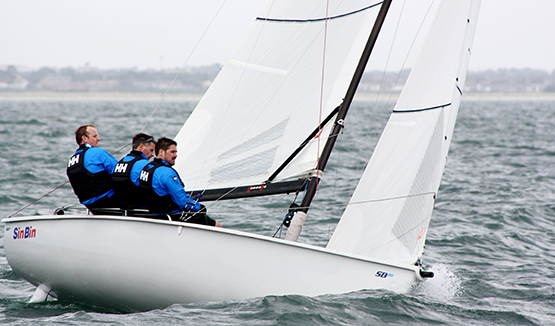
SB20 – Photo: Michael Keogh
Cockpits are usually fully open and the only covered area is a very small and spartan fore-cabin (cuddy), usually used only for storing sails and essential safety equipment. Even larger sports yachts which often do have a proper cabin below are often missing all the usual features of a yacht. Sinks, toilets, bunks, water tanks and cooking equipment are usually missing. Often a moulded hard plastic seat on either side of the cuddy and a removable chemical toilet are the only amenities.
In summary:
From the defining characteristics of “what is a sportsboat”, a few self-evidences emerge:
- They are ideally suited to take part in the type of racing organised by DBSC
- They are far removed in terms of design and sailing characteristics from the “traditional” keelboats designs which the IRC Rating System is ideally suited to “regulate and time compensate” in mixed fleets- Though broadly fitting the design principles above, they hugely vary in terms of LOA, performance, built materials etc etc…(see the “world of sportsboats”).
- All sportsboats are conceived, designed and marketed as “one-designs” though, to the notable exception of the Cork 1720 and SB3 in the past, it is difficult to see the establishment of a new Sportsboat one-design class in Ireland and furthermore in Dublin Bay alone. The latest example being the initial “hype” around the J70 when it was launched which only translated in 1 being purchased and campaigned…
- Why is DBSC considering a mixed sportsboat class?
- There is now a good number of non SB20 sportsboats based in Dun Laoghaire; privately owned J80s & J70s,
Clubs’ 1720s, others...
- There is maybe also a renewed interest among “younger” waterfront Clubs’ members to acquire a keelboat and go racing in DBSC…
- However, gone are the boom times when a string of J109s appeared in Dublin Bay…would be competitors are looking at a maximum capital outlay of €15k to €20k for “something exciting”…
- Due to their lack of unnecessary (for day racing) equipment (costly inboard engines, fridges, showers etc…) and
lack of accommodation, second-hand sportsboats offer great value for money compared to “affordable” cruiser racers.
Below are 2 boats for sales ads (besides each other) from apolloduck.co.uk under the category “racing
boat”: Hunter 707 - £4,750 CORBY 25 - £37,500
The first one (Hunter 707) having not been conceived and designed as a “cruiser-racer” has either no “cruiser” class to comply with and compete in or would not be competitive at all under IRC rating.
The 2nd one (Corby 25) would be of interest to anyone wishing to have a go at the Cruiser II class…however it is 7.9 times the price!!! (Are they THAT different? Is it 7.9 times the boat?!?).
- The only possibility currently to race a sportsboat (other than SB20) in Dublin Bay is to enter a 1720 in the Ensign Class on Tuesday evening…
- Providing a mixed sportsboats class in DBSC next year would not only cater for the existing boats (SB20 & 1720s in the main) but also foster and encourage new buyers to source “fun” affordable day racers (see the world of sportsboats)
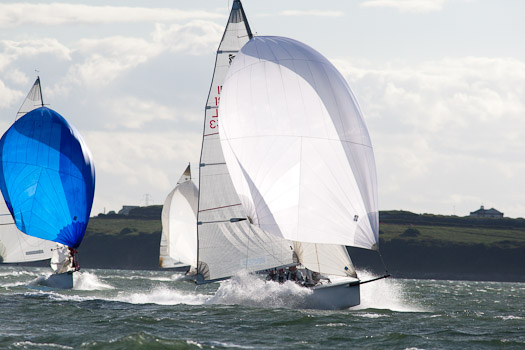
Ireland's own sportsboat – the 1720 . Photo: Bob Bateman
How to cater for a huge potential diversity of sportsboats in a “sporting fair way”?
There is a huge difference in LOA, sail area and design between various sportboats. Can they be mixed in the same class, on the same start?
Introducing clear, non-arbitrary definitions and “class rules” is paramount to gain traction and acceptance from all parties.
To this end, a very interesting case scenario exists in the UK:
The Forth Yacht Clubs Association (FYCA), the forum for clubs on both sides of the Firth, came to the
following solution when faced by a similar issue:
As seen before, Sportsboats are lightweight planing yacht designs that have distinctly different performance characteristics compared to conventional displacement yachts. If race conditions permit hydrodynamic planning then standard handicap values, that are mainly based on displacement performance, are not representative.
Yachts with RORC Sportsboat Ratings (SBR)1 range from those that plane readily such as the Melges 24, Cork 1720 and Laser SB3, to more conventional designs that do so only rarely.
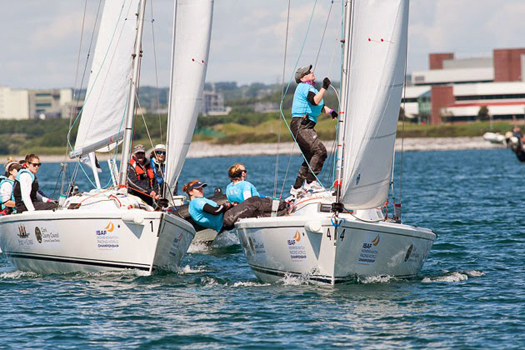
The J80. Photo: Bob Bateman
FYCA clubs organising separate classes for sportsboats and displacement yachts, to promote better and fairer competition whatever the wind and sea conditions, required a sportsboat definition to differentiate between ‘high performance’ and more conventional sportsboats. The FYCA Handicap Committee proposed a sportsboat definition based on design analysis rather than arbitrary classification.
After consultation with Mike Urwin, Technical Director of the RORC Rating Office that provides IRC and SBR certification, the following ‘high performance’ sportsboat definition was recommended:
• Downwind power to weight ratio >= 0.50
(SA/D^0.67 based on total downwind sail area m^2 [Main+Spin] divided by total displacement Kg^0.67 [Including crew weight])
• Displacement to length ratio <= 170
(DLR = (27.87 x IRC Displacement)/LWP^3 as defined by RORC measurement rules)
1 More on rating system below
The table below details the analysis of sportsboat designs compared to conventional displacement
yachts.
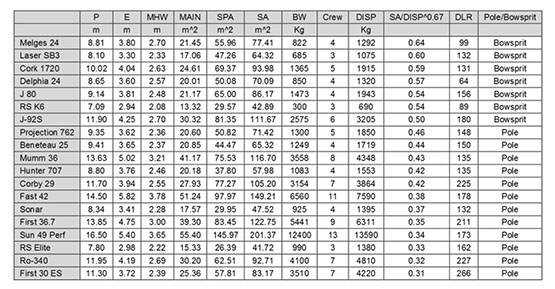
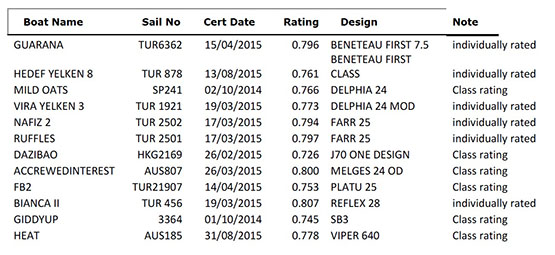
In turn, using Mike Urwin definition of high / low performance sportsboat, it is possible to plot the following
graph:
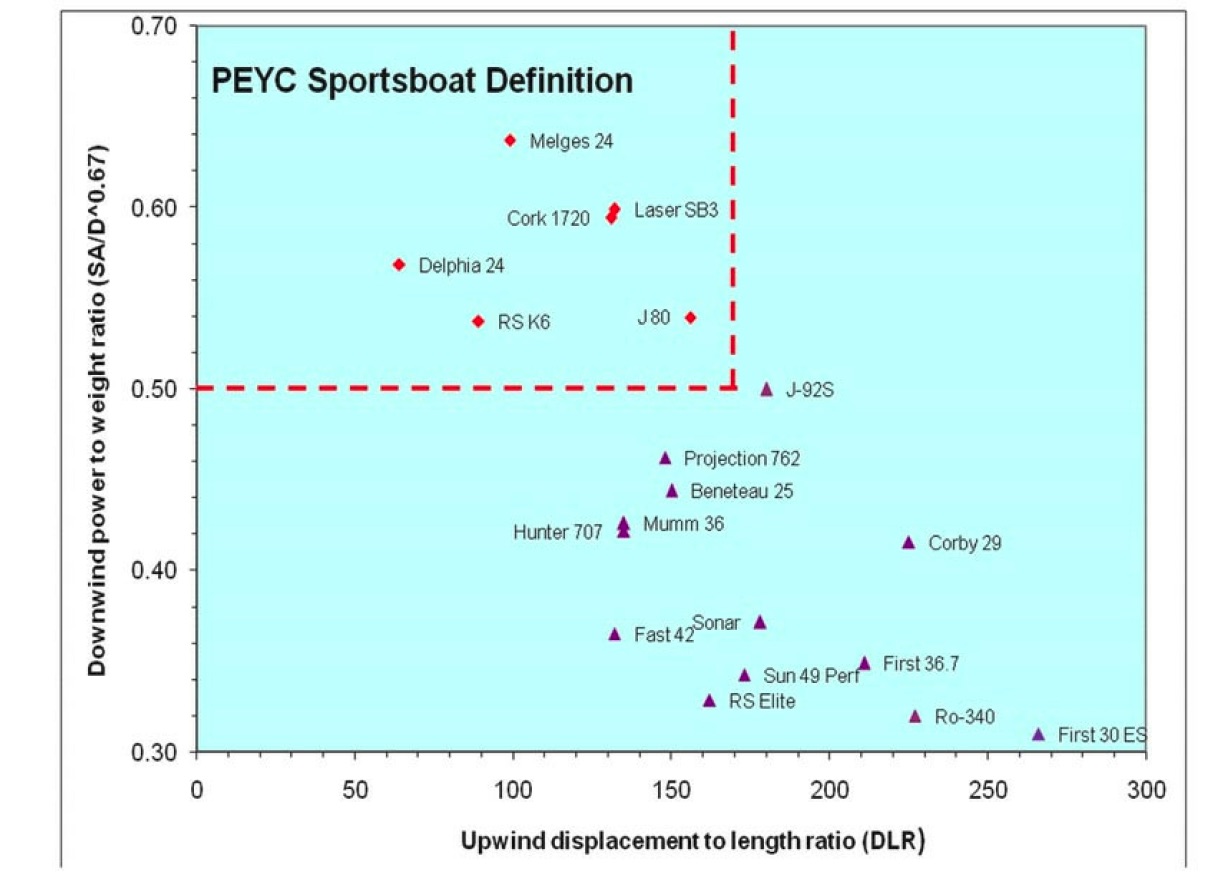
“Plotting” boats show categorically that, in fact, SB3s and Cork 1720s are extremely close in their designed performance! Maybe the fact that both boats were designed by Tony Castro is no coincidence?
Also, it is made much clearer that:
The following SBR rated designs are classified as ‘high performance’ sportsboats:
• Melges 24
• Cork 1720
• Laser SB3
• Delphia 24
• RS-K6
• J-80
The following SBR rated designs are not classified as ‘high performance’ sportsboats:
• Projection 762
• Beneteau 25
• Hunter 707
• RS Elite
• Sonar
In conclusion to these considerations:
- The existing “sportsboats” based in Dun Laoghaire naturally form a “homogenous” (by designed performance) group which, following Mike Urwin’s classification, could be amalgamated in a new “High Performance Mixed Sportsboats Class”
- There is also potentially room to create a “Low Performance Mixed Sportsboats Class” to foster the acquisition by “new comers to DBSC” of great value for money and great sailing boats such as Hunter 707s, Beneteau 25s (=Farr Platu 25), Projection 762s and, speaking from my own experience, Brenta 24s and 747 ODs
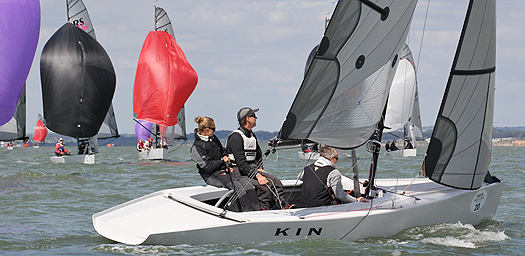
RS Elite
OK, but which handicap system?
Sportsboats at first raced in existing class divisions under existing handicapping systems. As the number of sportsboats continued to grow specific divisions for them have become increasingly common at all levels of racing.
In Europe and the USA, the trend has been more for One Design racing.
Sportsboat-specific handicapping systems include:
- RYA/RORC Rating: Sportsboat rule SBR
- Individual country rule systems such as the New Zealand Sportsboat box rule and Australian SMS system.
SBR:
The RYA/RORC Sportsboat Rule (SBR) was introduced in 1996 as a joint venture between the RYA and the RORC. The numbers of individual boats rated each year have fluctuated largely as a result of popular classes using the rule prior to becoming Recognised One Designs with the highest number rated in any one year being around 250.
Over the successive years, the number of individual boats rated has fallen to just 48 in 2009, therefore the RYA and the RORC have taken the decision that SBR will be discontinued with effect from 1st January 2011 (1st June 2011 in Southern hemisphere countries)
In 2004 and 2010, Cork Week had a mix sportsboat fleet with results calculated using SBR rating certificates. Both the RYA and the RORC were however concerned that the sportsboat fleets should continue to be able to race. To ensure this the RYA promoted and establish Portsmouth numbers for as a few standard sportsboat designs:
Below is a table of compiled of “older” PY ratings found and compiled on an “ad-hoc” basis: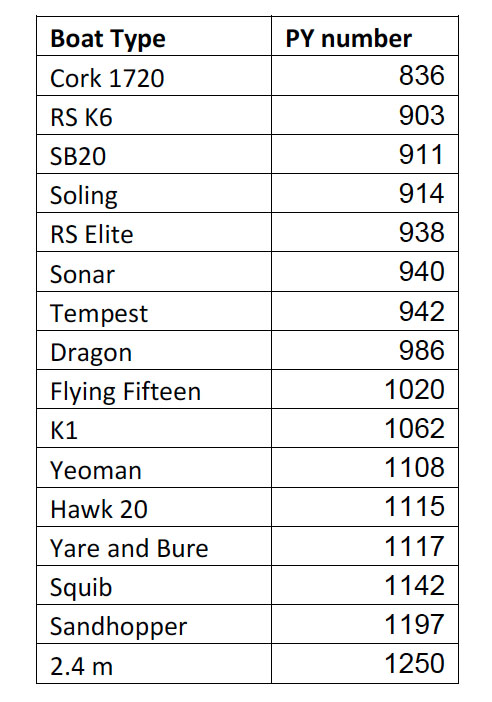
However, only a few are officially listed as a class with a maintained PY handicap on the RYA website for 2015 here

In conclusion, for the purpose of producing fair results in a mix-sportboat class (or classes) in a Irish / Dublin context, we can neither use the defunct SBR (based on boat measurement) system nor its PY “successor” based on results averages in club races in the UK.
We need to look further afield in racing “jurisdictions” where sportsboats are numerous, varied in design and regularly raced. The Australian SMS system (http://www.raceyachts.org/)
The Sportsboat Measurement System (SMS) was introduced in 2008 and during the years has grown substantially. It is now being adopted in a number of other countries and includes many different classes that fit the definitions of a sportsboat.
For example, in Turkey, an active fleet has been established at Kalamış Sailing Club and Sukru Sanus has
measured an inaugural fleet under the SMS system.
The Australian SMS system is also in use in Hong Kong; The sportsboat fleet in Hong Kong voted to adopt SMS and has measured Magic 25's under SMS as a One Design fleet (ie once a boat is rated, all other boats compliant with the particular sportsboat class measurements can use the same rating – see rated boats below)
With new technology and innovative designs, it is impossible to remove all of the inequities on a permanent basis, so the SMS rating formula is updated on a 4 year cycle in line with the issue of each new Racing Rules of Sailing (so updated in 2012, next update in 2016) to accommodate modern designs.
Pricing is also very reasonable. The fee structure was as below for 2015: AUS$ €
Initial Certificate $75.00 €47
Review of Rating $65.00 €41
Revalidated Certificate $65.00 €41
Amended Certificate $65.00 €41
Copies of Certificates $40.00 €25
Test Certificate $40.00 €25
Change of boat name/owner $35.00 €22
SMS system – empirical assessment
The SMS system was first used at the 2008 Meridien Marinas Airlie Beach Race Week, pictured below.
The event had been the test track for new design concepts in this rapidly expanding and exciting class of yacht racing , giving race officials a problem in equating a fleet that ranged from Elliot 7s through to the hitech Stealth 8s and a one-off sports boat designs
With the exception of one boat - the smallest and least expensive in the fleet - corrected time results under SMS have been 'quite equitable' across the fleet, resulting in generally close handicap results, according to Australian Sport Boats Association (ASBA) secretary Cam Rae.
'We are very pleased with SMS,' Rae said. 'If you look at the results in each race to date you will see close results on corrected time. In race one the top nine boats were less than four minutes apart. In that race we saw two of the fastest and most expensive boats, Vivace, an original Bethwaite 8, and Conquistador, a new sports 8 xx, split by Quantum Sailing, an Egan 6, and probably the least expensive boat in the fleet.'
Boats rated under SMS
There are currently 117 sportsboats rated under the Australian scheme. Some avail of a “Recognised One Design” handicap (ie all boats compliant with their OD class measurements use the same handicap), some have been measured individually as either once off or modified from their original one design measurements.
Below is a sample of European boat types rated;

Conclusion on Sportsboats rating system considerations:
The Australian SMS is available for DBSC to use as an affordable, well documented, user friendly and up–to–date, sportsboat specific handicapping system.
It is also notable that the freeware and well known result calculating software “Sailwave” natively support calculating results under the Australian AMS handicap system (and by extension the SMS one by simply inputting the SMS values for each boat in the rating field of the series file)…for an example of such results, please click here
Key recommendations for consideration by DBSC
This document advocates:
- The creation of a mixed-sportboat class
- The use Australian SMS rating system and Sailwave for results if unsupported by YR3
- Eventually / potentially, depending on numbers, the creation of a “high performance”
sportboat class and a “low performance” sportsboat class using Mike Urwin defintions or a
SMS Rating band in line with the IRC bands used by DBSC.
Notes:
- There is no equivalent of “endorsed certificates” in the SMS system
- For practical, speed of introduction of the rating system and to limit the costs to owners, it is
therefore possible to:
o Allocate an already existing SMS rating for previously measured one design boats
(J70 etc)
o Measure 1 boat representative of a group of boats (thinking of the modified 1720s in
use by the RIYC, RSGYC and NYC) and allocate the same SMS rating to all
o “fine” tune rating for individual boats at the request of individual owners…
The world of sportsboats
I have compiled a non exhaustive online database of common sports boats and their characteristics here
Document prepared by Olivier Prouveur
Sailing Manager
National Yacht Club


























